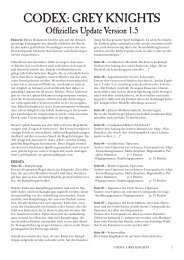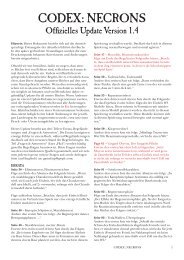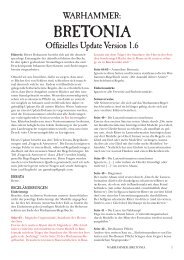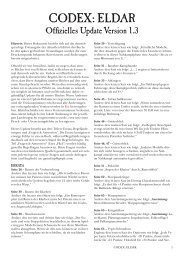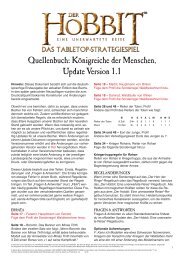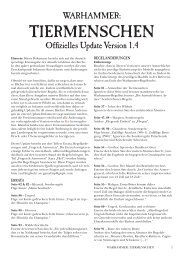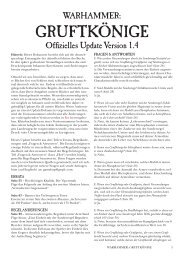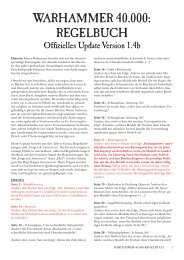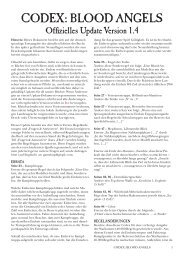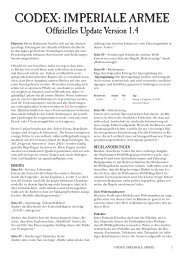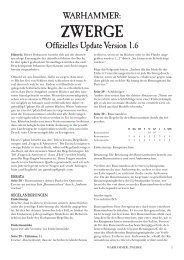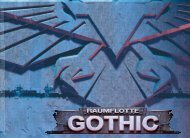Necromunda rulebook - Games Workshop
Necromunda rulebook - Games Workshop
Necromunda rulebook - Games Workshop
You also want an ePaper? Increase the reach of your titles
YUMPU automatically turns print PDFs into web optimized ePapers that Google loves.
NECROMUNDA<br />
SCENARIO 5: THe raid<br />
Gangs rely upon trading contacts and friends to generate their income, either by providing cash, food, shelter,<br />
or by trading things the gangs discover in the wastes. These are all known as territories, although some<br />
territories actually take the form of contacts with third parties rather than physical places in the Underhive.<br />
A gang’s territories are always vulnerable to attack by other gangs, and one of the most effective ways of<br />
crushing a rival gang is to raid its territories.<br />
In the Raid scenario one gang attacks the territory of<br />
another. The territory is guarded by one or more<br />
sentries and additional reinforcements are close at<br />
hand. The raiders must eliminate or get past the<br />
sentries, destroy the objective and then get away as<br />
quickly as possible.<br />
This scenario introduces new rules for sentries which<br />
make the game particularly nail-biting. The scenario is<br />
slightly more complex than earlier ones and is worth<br />
leaving aside until you have a firm grasp of the game<br />
rules.<br />
TERRAIN<br />
In this game the player who picked the scenario is the<br />
attacker and the other player is the defender.<br />
Starting with the defender, each player takes it in turn<br />
to place a piece of terrain, either a ruined building<br />
structure or a connecting walkway. It is suggested that<br />
the terrain is set up within an area 4' x 4' or<br />
thereabouts.<br />
The tabletop represents the most valuable of the<br />
defender’s territories. If the defender has several<br />
territories of equally high value then the attacker may<br />
raid whichever he likes. The terrain is either the<br />
territory itself or the entrance to it (such as a mine or<br />
tunnel entrance, hole or water still) or a part of the<br />
Underhive that a contact has asked you to protect or<br />
search (such as a Guilder contact, Friendly Doc, the<br />
owner of a workshop, or friends in an Underhive<br />
settlement.)<br />
RAID OBJECTIVE<br />
After the terrain is set up the defender places the<br />
Gateway piece anywhere he likes on the table. This<br />
represents the entrance way to the mine, hole, tunnels<br />
etc. Possibly it leads to an underground store<br />
containing a valuable find that one of the defenders’<br />
contacts has asked them to protect or transport. Players<br />
should feel free to invent something they feel is<br />
appropriate for the type of territory being raided. The<br />
raiders must destroy the Gateway to win the game.<br />
The Gateway structure has a Toughness of 6 and can<br />
sustain the equivalent of 3 wounds before it is<br />
destroyed.<br />
116<br />
GANGS<br />
The defender sets up first. He deploys up to D6 of his<br />
gang as sentries, choosing which fighters he wishes to<br />
put on sentry duty. Sentries may be placed anywhere on<br />
the table at least 8" away from a table edge.<br />
The attacker then deploys his gang within 4" of a<br />
randomly selected table edge. The attacker has 2D6 of<br />
his gang fighters for the raid; the remaining fighters are<br />
not available as they have been left behind so as not to<br />
draw attention to the raiding party and to protect the<br />
gang’s own territory against reprisals. The attacker may<br />
choose which of his fighters he will commit to the raid.<br />
STARTING THE GAME<br />
The attacker takes the first turn of the game.<br />
SENTRIES<br />
Until the alarm is sounded (see below) sentries move<br />
D6-3 inches per turn. Roll separately for each sentry to<br />
determine how far he moves. If the distance is negative<br />
then the attacking player is allowed to move the sentry<br />
model. For example, a roll of 1 gives a move of -2, so the<br />
attacker moves the sentry 2" in any direction.<br />
After moving each sentry, roll the Scatter dice, and turn<br />
the model to face the direction indicated.<br />
SOUNDING THE ALARM<br />
Until the alarm is sounded sentries move as described<br />
above. In addition their Weapon Skill is halved (rounding<br />
fractions up) and they may not shoot any weapons.<br />
After the alarm is sounded sentries may move and attack<br />
freely. In addition, the defender may bring on<br />
reinforcements as described below.<br />
The alarm can be sounded in a number of different ways:<br />
Spotting. Roll 2D6 at the end of the defender’s turn.<br />
Sentries can try to spot any raiders that are within the<br />
distance rolled so long as they could normally be seen –<br />
ie they are within his arc of vision.<br />
Raiders in the open will be spotted on the D6 roll of 2 or<br />
more.<br />
Raiders in partial cover will be spotted on the D6 roll of<br />
4 or more.<br />
Raiders in cover or hiding will be spotted on the D6 roll<br />
of a 6.<br />
Sentries will spot any raider within their Initiative<br />
distance in inches on the D6 roll of a 2 regardless of<br />
cover or hiding. For example, a sentry with Initiative 4<br />
spots hidden raiders within 4" on a roll of 2.



